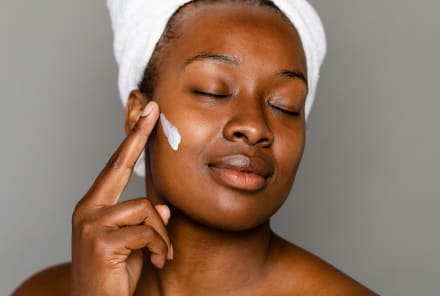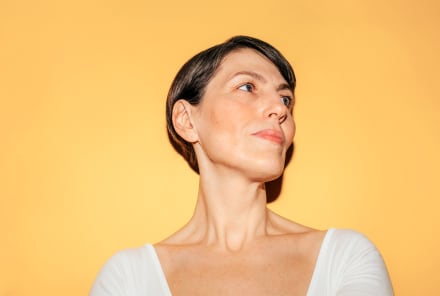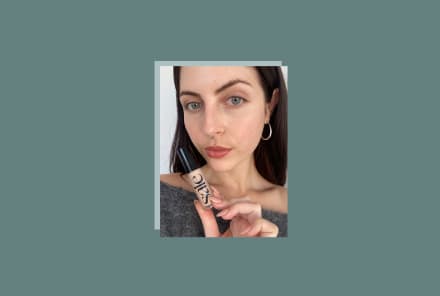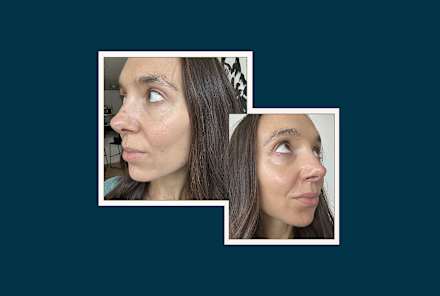Advertisement
Everything You Should Know About Coffee & Acne, From Research


People can make a far-fetched case for just about anything causing acne. And while it would be great to have one singular trigger for breakouts—and therefore one single effective treatment—that's just not how acne works.
There are so many things that contribute to breakouts, from genetics to hormones to lifestyle and yes, your diet.
Some foods have been linked to breakouts in clinical studies, but is coffee actually one of them? Here's what experts have to say and how to deal, especially if you're a coffee lover.
Does coffee cause acne?
Whether or not coffee can trigger breakouts is not a cut-and-dried answer—like, by any means. There are so many things that influence acne, and there's also plenty of variety when it comes to coffee.
But rest assured coffee lovers, "There isn't evidence to support that coffee itself can directly cause acne," board-certified dermatologist Ramya Garlapati, M.D., tells mbg. "However, there is some supportive evidence that the way coffee is consumed can potentially lead to acne," she notes.
Depending on how your body reacts to caffeine, the way you drink it, how much you consume, etc., all change the answer a little bit. There are various factors that can impact your skin related to how you use coffee in your daily life, and we're about to dive into each one of them and offer a solution to every potential problem.
Summary
Coffee can trigger stress
Given that the consumption of caffeine releases adrenaline, it can make people feel jittery, shaky, and restless. Caffeine may also increase cortisol—the stress hormone—both at rest and during periods of high stress, research shows1.
However, for those who regularly consume coffee, this spike will be less significant than that of those who drink caffeine on occasion2.
High cortisol levels trigger a chain reaction in the body including activating sebocytes, the epithelial cells that produce sebum—the waxy, oily stuff that protects the skin. However, when sebum production is cranked up too far, that is linked to acne3.
What's more, "[One study on stress and wound healing4] has shown that stress can slow down healing, which may worsen acne and acne scarring," board-certified dermatologist Jaimie Glick, M.D., once told mbg.
To sum up, caffeine can stimulate a stress response in the body, which can lead to increased sebum production and slower wound healing, resulting in more breakouts that last longer and scar easier.
The fix:
How much you drink can influence your breakouts
Here's the thing: One cup of coffee likely isn't going to put your body into a state of extreme stress, though for some people—those sensitive to caffeine and children—it certainly can. How much coffee you can consume without feeling the negative side effects depends on a few factors, metabolism rate included.
The general limit for daily caffeine intake is 400 mg5 (or about four cups). However, if you know your metabolism runs on the slower side—or four cups make you feel jittery—a maximum of two cups a day is going to be your best bet.
The goal here is to limit the side effects of consuming too much caffeine6, which include:
- Fast heart rate (tachycardia or palpitations)
- Jitteriness
- Anxiety
- High blood pressure
- Sodium and water retention
- Electrolyte imbalance
- Dehydration
- Insomnia
- Headaches
- Digestive issues (such as frequent bowel movements, indigestion, acid reflux)
The fix:
Coffee can disrupt sleep, which causes acne
As you very well know, caffeine can impact your sleep—which at times is kind of the point—as caffeine helps to wake up your brain and keep it alert, two things essential for many of us to keep up with a busy schedule. However, studies show that consuming a dose of caffeine (specifically 400 mg7 in this study) up to six hours before bedtime has "important disruptive effects" on your sleep.
Not only might you have more trouble initially falling asleep if you're buzzing on caffeine, but the study demonstrates interrupted sleep as well.
A lack of high-quality sleep will increase cortisol levels, which, as you now know, can manifest into more sebum production and more breakouts. Even if you don't typically have acne-prone skin, a lack of sleep can contribute to what dermatologists refer to as "occasional acne8."
The fix:
Coffee can be dehydrating
As mentioned earlier, too much caffeine can lead to a dangerous loss of body fluid. But even if you're consuming 400 mg or less, you can still get dehydrated. While consuming a moderate amount of caffeine does not directly dehydrate you, studies reveal9, you're more likely to skip a glass or two of water if you always have another beverage in hand.
Dehydration can lead to situationally dry skin. While this doesn't seem like a trigger for acne at first, it actually is. This is because when your skin is dry, it craves moisture. If you don't replenish it, whether it be topically or internally, your skin creates more sebum to compensate and essentially attempts to self-moisturize.
This is similar to how your skin behaves during air travel—the air in plane cabins tends to dry out the skin, making it produce oil and break out because of it. This is another type of occasional acne to look out for post- or during travel.
Plus, when your skin is dried out, you run the risk of disturbing your skin's moisture barrier. This can make active acne worse and lead to redness, irritation, and sensitivity.
The fix:
Adding sugar can cause breakouts
According to the American Academy of Dermatology (AAD), a low glycemic index diet, (an eating plan based on how foods affect blood sugar levels), may lead to fewer pimples. In one study, 2,258 patients were placed on a low glycemic index diet, initially to study weight loss.
As a secondary result, "This diet also reduced their acne, with 87% of patients saying they had less acne and 91% saying they needed less acne medication," the study showed. All this to say, what foods are categorized as high glycemic index?
Foods like white bread, many breakfast cereals, white potatoes, pineapple, watermelon, and of course, refined sugar, all score above 70 on the glycemic index—aka, they're high in sugar and release quickly into the body. This quick release causes a blood sugar spike, which is what may trigger acne.
See when your blood sugar spikes, it causes inflammation throughout the body. "These spikes also cause your body to make more sebum, an oily substance in your skin. Both inflammation and excess sebum can lead to acne," as stated in the AAD review.
So what does all of this have to do with coffee? Well, whether it be from a cafe or the market, many creamers are packed with sugar. This doesn't mean there are no blood-sugar-friendly sweeteners, but you'll likely have to be mindful of it.
The fix:
Animal milk is connected to worsening acne
Cow's milk may be a low-glycemic beverage when consumed alone, but it's not the best for breakouts. "The type of milk added to coffee can possibly lead to acne as studies have shown that consuming low-fat or skim milk has been associated with a higher incidence of acne as compared to consuming whole milk or no milk at all," Garlapti says.
In one study noted by the AAD10, with a total of 47,355 women, 6,094 girls, and 4,273 boys, a strong link between cow's milk and acne was demonstrated:
- Women who drank two or more glasses of skim milk a day were 44% more likely to have acne than others.
- Girls aged 9 to 15 years old who drank the most cow's milk (whole, low-fat, or skim) were more likely to have acne.
- Boys aged 9 to 15 years old who drank skim milk were more likely to have acne.
The AAD notes a theory that hormones in the milk may lead to inflammation in the body, which, as stated above, puts one at a higher risk for breakouts. Milk consumption has also been linked to an increase in IGF-1 Levels11, which stimulates oil glands to produce more sebum (the oily substance that protects your skin from drying out). This has the downstream effect of more acne.
The fix:
Coffee quality can affect the gut and skin
This may come as a shock, but coffee can contain mold, thanks to the presence of ochratoxin A.
This mycotoxin (aka a toxic chemical produced by fungi) has been found to have negative effects on bodily health in animals, as studies show it can damage kidneys in all mammals12.
However, more studies are needed before we can make the link to humans as well, cardiologist Joel Kahn, M.D., once told mbg. That being said, it's still considered to be nontoxic to humans13 as of now.
All of this to say, roasting coffee beans may destroy ochratoxin A14, but it may depend on the type of roasting and particle size, Kahn said.
If there are pesticides or mold in your coffee, your gut microbiome will be directly affected—and not in a good way. The gut and skin have a strong link—which you can read all about here.
The fix:
However, coffee is full of antioxidants
Now, reading all of this, you might be thinking that coffee has zero health benefits, but that's actually not the case—not even close.
There's tons of benefits to consuming coffee daily, a few of which include:
- Decreased risk of Type 2 diabetes15.
- Lower risk of depression16.
- Lower risk of heart disease17.
- Overall lower risk of death18, regardless of age, weight, and alcohol consumption.
- Moderate consumption improves your gut microbiome profile.
Some of these benefits may be due to coffee's antioxidant content—as it's actually one of the most antioxidant-rich beverages19 next to tea and red wine. Consuming antioxidants is great for the skin—both in terms of acne and physical skin aging thanks to their ability to fight off free radicals.
Research shows that it can offer a boost for protection against skin cancer20 too, including melanoma (the most serious type of skin cancer).
As a quick refresher, free radicals can put the skin into a state of oxidative stress. This can speed up the skin aging process21. Oxidative stress can also impact your skin barrier function, which can exacerbate acne.
Definition: Antioxidants
Plus, coffee can bring joy to your life
We must mention that one of the major benefits of coffee is that you enjoy it! Coffee can encourage joy, productivity, and an overall good feeling for many of us—which is partially why it's so widely consumed.
If the thought of cutting out coffee bums you out, don't worry—you don't have to completely cut it from your life in order to avoid breakouts. Simply cutting off consumption at 400 mg and being mindful of how you consume it by crafting up a skin-loving cup will do the job.
How to build a better cup of coffee for your skin
That was a ton of information—so here's all of the evidence pulled into one cup of coffee that's not only safer for your skin but might actually help your breakouts in the long run:
- Limit your coffee intake to 400 mg (or four cups) or 200 mg (or two cups) if you have a slower metabolism or feel jittery or anxious with more than two cups.
- Opt for decaf coffee if you're nearing your personal caffeine limit but still crave the flavor.
- Cut off caffeine intake six hours before bedtime.
- Make sure to buy organic, high-quality coffee when you can.
- Use plant-based milks—specifically almond, coconut, and flax.
- Limit sugars and syrups—instead, opt for natural sweeteners or no sweetener at all.
- Add collagen powder to boost the benefits—here's a list of our favorites from a nutrition Ph.D.
- Mind your water intake throughout the day.
Coffee alternatives to try
Now, if you've tried everything and find that coffee still leads to breakouts, there are plenty of alternatives. Or if you find that even one cup of coffee is a bit too much and makes you feel anxious, going with a lower-caffeine beverage might be the way to go. Here are a few coffee alternatives to keep in mind:
Tea
If you want a bit of caffeine but less than in coffee, then caffeinated teas might be a better fit. A few good options include:
- Matcha: 70 mg caffeine per cup
- Black tea: 48 mg caffeine per cup
- Green tea: 28.8 mg caffeine per cup
Energy-enhancing supplements
If you're just looking for a focus aid that doesn't make you jittery, there are supplements out there for just that purpose. Some of these formulas slowly release caffeine (which is the opposite of consuming coffee).
This might help you keep all of the efficiency caffeine can bring, sans the negative side effects. Here's a list of 16 A+ options to pick from if you're ready to try out a new approach.
Blood-sugar-balancing foods
If coffee is a no-go for you but you still need a natural energy boost, then look for blood-sugar-balancing foods for a pick-me-up that lasts longer. Here are a few to get you started.
Mushroom coffee
Mushroom coffee has been used for centuries in medicinal practices and has more recently been used in the modern health scene as a caffeine alternative. There are tons of benefits to consuming mushrooms, even if you're only swapping out one of your daily coffee beverages a day for this mushroom blend.
How to counterbalance coffee's effects on the skin
Let's be real—acne is a nuanced skin condition with a long, long list of causes and treatments. So if you'd rather not try quitting coffee as your first step to reducing breakouts—we get it. There are so many other ways to encourage clear skin, including:
- Skin cycling
- Getting regular facials from a trusted esthetician.
- Use topical retinol or prescription-grade retinoids.
- Addressing hormonal acne with a medical professional.
- Start elsewhere in your diet—like reducing dairy and sugar.
- Use stress management tools, like nature walks, meditation, mindfulness, and breathwork
Most of all, if you're struggling with acne, it's best to visit a dermatologist if you can. Trying to find the cause of your breakouts can feel like a never-ending game of Clue—which, as you know, will only increase stress.
The takeaway
As you can tell now, there's nothing straightforward about the link between coffee and acne. To be frank, it all boils down to how much you consume, how you prepare it, and how much you prioritize other skin habits like topical skin care, sleep, hydration, hormonal balance, etc.
If you're on a mission to clear your skin, our beauty breakdown on acne is a safe and heavily researched place to start—it includes a guide to the different kinds of pimples, the many causes, and which treatment may be best for you, all backed by dermatologists. Oh, and here's our favorite moisturizers for acne.
21 Sources
- https://pubmed.ncbi.nlm.nih.gov/9710300/
- https://www.ncbi.nlm.nih.gov/pmc/articles/PMC2257922/
- https://www.ncbi.nlm.nih.gov/pmc/articles/PMC4106357/
- https://www.ncbi.nlm.nih.gov/pmc/articles/PMC2792763/
- https://www.fda.gov/consumers/consumer-updates/spilling-beans-how-much-caffeine-too-much
- https://www.ncbi.nlm.nih.gov/books/NBK532910/
- https://www.ncbi.nlm.nih.gov/pmc/articles/PMC3805807/
- https://www.ncbi.nlm.nih.gov/pmc/articles/PMC6489559/
- https://www.ncbi.nlm.nih.gov/pmc/articles/PMC3886980/
- https://pubmed.ncbi.nlm.nih.gov/15692464/
- https://www.ncbi.nlm.nih.gov/pmc/articles/PMC7847434/
- https://www.ncbi.nlm.nih.gov/pubmed/12693831
- https://www.ncbi.nlm.nih.gov/pmc/articles/PMC4247821/
- https://www.sciencedirect.com/science/article/pii/S0956713513002971
- https://pubmed.ncbi.nlm.nih.gov/29590460/
- https://pubmed.ncbi.nlm.nih.gov/26339067/
- https://pubmed.ncbi.nlm.nih.gov/29276945/
- https://pubmed.ncbi.nlm.nih.gov/31055709/
- https://www.ncbi.nlm.nih.gov/pmc/articles/PMC4665516/#:~:text=Antioxidants%20and%20Antioxidant%20Activity,of%20antioxidants%20consumed%20by%20people.
- https://pubmed.ncbi.nlm.nih.gov/27902644/
- https://pubmed.ncbi.nlm.nih.gov/25906193/












